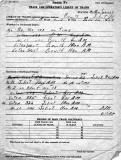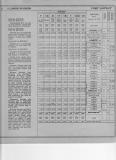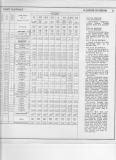
| Home | Open Account | Help | 233 users online |
|
Member Login
Discussion
Media SharingHostingLibrarySite Info |
Nostalgia & History > QuestionDate: 11/13/17 08:41 Question Author: ntharalson I suppose I should put this on the Railroaders' Nostalgia Board, but since I'm not a railroader,
I'm going to put it here. This past weekend, I was out along BNSF's Transcon, the former ATSF, in Missouri. A track gang was working between Baring and Rutledge, and of course, a Form B was in effect with trains calling the track foreman for permission to pass through the limits. (As a railfan, I love Form B's.) I got to wondering just how this got accomplished before radios came into widespread use. Was there some form of telephone connection, or just a hard window? (That is, line closed from X to Y time to get the work done.) I'll look forward to any answers, and if one of you wants to cross post this to the Railroaders' Nostalgia Board, I won't be offended. Nick Tharalson, Marion, IA Date: 11/13/17 08:57 Re: Question Author: HotWater From what I remember in the 1950s, with Train Order operations, the train crew received a TO giving the MP location of the "protected" work area. Flagmen were stationed at both ends of the work area, would either stop the oncoming train (red flag) or flag the train past (green flag).
This subject is probably best answered by TAW. Date: 11/13/17 09:19 Re: Question Author: Railbaron While I'm sure every railroad had something similar SP issued a "Form Y" trainorder giving limits of work and where the red "stop sign" (it was not a flag in this case) would be. Trains would be authorized to proceed by the flagman giving a signal with a Green flag, in which case the train could proceed at Restricted Speed, or the foreman could orally authorize movement and give a different speed.
As a note, SP had a very specific format printed on the ETT that had to be followed for the oral authorization. Edited 3 time(s). Last edit at 11/13/17 09:27 by Railbaron. Date: 11/13/17 09:48 Re: Question Author: spnudge The form "Y" had unusual flags. "Conditional Stop" was printed on the red flag.
Nudge Date: 11/13/17 10:09 Re: Question Author: Railbaron spnudge Wrote:
------------------------------------------------------- > The form "Y" had unusual flags. "Conditional Stop" > was printed on the red flag. > > > Nudge As a point of clarification, the yellow "PROCEED PREPARED TO STOP" and red "CONDITIONAL STOP" were signs, not flags, on SP. (SP rulebook, "Forms Of Train Orders" - "Form Y") Date: 11/13/17 14:02 Re: Question Author: TAW ntharalson Wrote:
------------------------------------------------------- > I suppose I should put this on the Railroaders' > Nostalgia Board, but since I'm not a railroader, > I'm going to put it here. > > This past weekend, I was out along BNSF's > Transcon, the former ATSF, in Missouri. A track > gang > was working between Baring and Rutledge, and of > course, a Form B was in effect with trains > calling > the track foreman for permission to pass through > the limits. (As a railfan, I love Form B's.) > I got to wondering just how this got accomplished > before radios came into widespread use. Was > there > some form of telephone connection, or just a hard > window? (That is, line closed from X to Y time > to get the work done.) > > I'll look forward to any answers, and if one of > you wants to cross post this to the Railroaders' > Nostalgia Board, I won't be offended. > The Form B is the 'modern' non-train order version of the train order form Y. Both allow maintenance work under traffic with the protection of being required to stop until the foreman in charge of the work gives the train permission to proceed through the work limits. That (for practical purposes) requires radio. The form Y train order came about only after the universal availability of radio communication between trains and MofW personnel. Before radio (and after, for that matter), any track could be occupied at any time under flag protection. That's fine for stationary work. Red flags either side of the work and torpedoes two miles back from the red flags. Trains would reduce speed prepared to stop when exploding the torpedoes. The train would then remain at the red flag until the crew's flagman removed it. The torpedoes either side of the work had to be replaced after the train passed. The crew's flagman might tell the engineer that the next torpedoes you hit are ours, keep on truckin', but that wasn't proper, let's say. It didn't work for moving from place to place such as a track inspector or a crew on the way to or from a job. That's where the track car lineup comes in. The track car lineup was authority for use of the main track by maintenance personnel. It worked the same as timetable authority for trains. If no train is due, the railroad is yours. If a train is due, you must clear or protect against it. If you need more (time), request a new figure from the dispatcher. The example is the Santa Fe. Santa Fe operators had the 'telephone rule' which prohibited anyone but operators from talking to the dispatcher. In the last sentence of the first long paragraph here https://www.trainorders.com/discussion/read.php?18,4412987 I referred to the time-consuming process of updating lineup times. The reason is that the lineup was authority to occupy the track. In that same post, I mentioned the lineups that were worthless the instant they were transmitted. A dispatcher would get some time off for a train overrunning a lineup (running ahead of lineup time), with good reason, since MofW were using the lineup as authority. I always protected lineup times by train order. The folks who thought that was too much work ridiculed me for it. Some of them got time for overrunning their own lineup (the one they issued). I can see missing something on a lineup you got in the transfer (not condone, but ok, maybe you missed something), but overruning a time you stuck out yourself? In order to not need to put a lot of care into the lineup, which some saw as needless extra work, they would show a train (an Extra West or Extra East) every 30 minutes for the duration of the lineup. Those trains didn't exist, but nobody could occupy the track because of those bogus times. The BN Maple Valley office fixed that be endorsing every lineup with Other trains may be run at any time. What's the point of the lineup? Oh...it's authority to occupy the track? Oh. The timetable is not current with the lineup, but it can be used to explain the principle. The lineup shows some regular trains on time. That means look at the times in the timetable. For example, 1/19 is on time. Using the 1958 times as an example, if you are working between Lemont and Romeo, you must be clear by 937am (clear the time shown by five minutes) or protect against No 19 (red flags, torpedoes as described above). Yes, it would be possible to protect against 1/19 and keep working. The rules allowed that. However, the explanation tomorrow morning had better be good. 1/19 goes by showing green. The dispatcher didn't give anything on 2/19, so you must stay in the clear, protect, or get more from the dispatcher (which involves calling Willow Springs on the block phone). 123 is on time, but if 123 shows up showing green, the same applies, even though 2/123 is not on the lineup. It's been a long time - let's say 30 minutes running time Corwith to Lemont. 51's extra (it wasn't a regular train, just a symbol) is on duty Corwith 6am. I can't remember the regular figure that was used, let's say 30 minutes after on duty to leaving (for the purpose of MofW figuring. The MofW guys have until 7am at Lemont or protect against 51's extra. The same applies to extra west Corwith 1000am - 1100am at Lemont and Corwith 1130am - 1230pm at Lemont. However, the lineup is dead at noon, so being out there after 1159a requires protection. The same procedure works for the eastward trains. BUT...this is Rule 261 territory. Trains on either direction may use either track. For the MofW guys, that means figure it like a single track railroad. In later years came the instruction that when a lineup was in effect, trains had to run right-hand unless the lineup said otherwise. Before then, MofW had to ask the dispatcher (via the operator) what track trains would be on or clear/protect on both tracks. Informing MofW when a train would be on the reverse (what would have been against the current of traffic in Rule 251 days) was not the responsibility of the dispatcher. It was the MofW folks responsibility to ask. Not only is this before the advent of Form Y orders, it is also before the advent of CTC permits (Track & Time, etc.). TAW    Date: 11/13/17 22:42 Re: Question Author: GN599 Thanks for taking the time to post all of that TAW. Pretty amazing more track guys weren't killed really, it's almost as if they were second class citizens or something sheesh. I have worked with a lot of guys that were out on the tracks in those days and they all have a story or two about a close call with a train because of working under train line-ups. : /
Date: 11/14/17 08:51 Re: Question Author: ntharalson Thanks to all, and specially TAW, for your answers.
Nick Tharalson, Marion, IA Date: 11/14/17 13:30 Re: Question Author: zr190 MY Dad was Section Foreman on the RI at Vinton, Iowa.
On the RI (uniform Code) they used a Form "U" order which was pretty much the same as a Form "Y". At any rate they never had a radio. They had to depend on the line up and their ears and eyes. Some of the Train Crews weren't above quietly (as much as possible) approach and stop at the Red Board and take a break. Another Lineup story... Several miles North of Vinton is an area that is called Stone Cut. Pretty descriptive. They were headed south on their motor car. The last ABS signal they passed was clear. They had to stop and put some bolts in a joint. They proceeded and found (met) a switch engine which was being deadheaded to Waterloo. Dad and his gang all bailed off with only scrapes/bruises. The eng was not on their lineup. After the lineup had been issued, it was decided they needed to get an eng up to Waterloo. The crew on the eng had a message that they were not on the Lineup and to sound whistle and bell freely, etc. The crew on the eng got an unpaid vacation. zr190 |